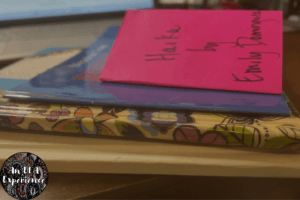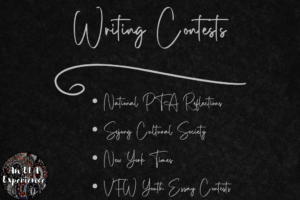It’s time to publish student writing! Whether it’s the beginning of the school year or the end, introduce your students to the joys of publication today!
Publish Student Writing on Your Walls

Let’s begin with the easiest way to publish student writing–hang it on the walls. Display it on bulletin boards, on classroom walls, or in the hallway for everyone who passes by to read and admire.
How to Publish on the Walls
My favorite way to do this is with a hallway clothesline. It takes around fifteen minutes to set it up, but once it’s hung, it saves time because you don’t have to bother pulling out staples or messing with tape. Plus, it looks super cute.
Staple a few lines of twine to a bulletin board or tape them to a wall. Cover up the ends with cutouts and add clothespins and students’ final drafts. If you don’t have time to make one, just tape students’ work somewhere for others to see. As simple as this is, it’s a great way to begin publishing student work.
Publish Student Writing with Student-Published Books

Another way to publish student work is by making books. Display these in your school library, send them home for the holidays, or let your students read them to younger learners (at your school or a neighboring elementary school, for example).
Five Ways to Make Books
Here are five ways my students have made books. Choose the ones that work best for your classroom.
Eight-Page Books
Make eight-page books. These are made from one sheet of paper, so they work best for books of poetry or shorter pieces. Fold a sheet of computer paper in half, hamburger style, three times. Then unfold so that you’re back to your first fold (where the paper is halved hamburger style). Next, cut a slit on the folded side up to the first crease. Now, unfold your paper and fold it again hotdog style (long). Holding the paper on each end, push it together so that it forms a book, and fold it into place so that you have eight pages (including back and front sides). Students title and decorate the covers, then write or paste their writings into them.

Bare Books
Buy blank books. Sometimes, after writing poetry, my students cut and paste their typed poems in them. Other times, they’ve included their narratives. To do this, we’ve used hardcovered books from Bare Books, which now sell for $2.75 each with 36 pages. However, I’ve since found some similar paperback books on Amazon for .79 each when you buy in bulk. Both include enough pages for everything a student could want–text, prologue, illustrations, dedication, table of contents, and about the author.

Google Slides or Microsoft PowerPoint
I’ve also had students create books using Google slides and Microsoft PowerPoint, which work great because they’re easy to illustrate. Resize the pages to 8 ½ x 11” (in the U.S.) so they fill up the page. Allow each student one to two pages, and create a class anthology or a school magazine by binding the pages together with a binding machine or by punching one to three holes into the pages and attaching them with yarn or rings.
You can also make a template for students by resizing the pages to 11 x 8 ½” (again, in the U.S.), inserting lines down the middle, and numbering the pages accordingly (back and front covers, pages 1 and 6, 5 and 2, and 3 and 4 on each half respectively). These can be printed double-sided and folded together to make individual books.

Storyjumper
We’ve also used Storyjumper to create books. My students liked working on this site, and parents can purchase downloads, paperbacks, and hardcovers of their children’s books.
Publish Student Writing on the Internet

Use the platforms you’re already required to maintain for publishing.
Where to Publish on the Internet
Post final drafts in Schoology, Google Classroom, Edmodo, or whatever portal your school uses, and allow students to read and leave positive comments to other writers.
Many districts require their teachers to have a website, so host a contest and post students’ writings there too. (Make sure you have signed permission slips first to cover FERPA laws.)
Publish Student Writing in Contests

This is by far my favorite way for students to publish (when my students win or even place). It says a lot to them and me when their writings are chosen from the hundreds, sometimes thousands, of other writers who entered.
Whatever contest your students enter, make sure to visit sites to read published examples before they start writing. These will give students an idea of what they need to do to win. Also, to ensure a good number of entries, plan in-class lessons that address required themes and genres, and choose contests, like the ones listed below, that don’t charge students to enter. And one more thing–help them edit before submitting entries.
Four Contests for Student Writers
Any Genre
The National PTA Reflections has been hosting a contest with a new theme every year for the last fifty years. They focus on the arts, offering competitions for dance, film, literature, music, photography, and visual arts. For literature, students can write fiction or nonfiction. If your school PTA representatives haven’t contacted you, then contact them. They will take care of the paperwork so you can focus on gathering submissions.
Sijo
Sijo is a Korean form of poetry. Like haiku, it has three lines (although it can also be broken up into six), but unlike haiku, it has fourteen to sixteen syllables per line. The Sejong Cultural Society explains sijos, provides examples, and hosts a yearly contest, which I’m proud to say one of my students placed in and won $50.00. (You can also read Linda Sue Park’s Tap Dancing on the Roof for more kid-friendly sijos.)
Personal Narrative
The New York Times hosts contests too, and this one sounds particularly inviting–a 100-word personal narrative. You’ll need to hurry though because the deadline is October 24, 2022. If you miss this one, take a peek at their 2022-2023 Contest Calendar for other contest opportunities.
Essay
Contact your local VFW to enter the VFW Youth Essay Contests. It’s held yearly and open to students from grades three through twelve. To enter, students write an essay that addresses the veteran-related theme, which allows them to not only enter a contest but also learn about the importance of our veterans. I’ve had a few students win monetary prizes with this contest too. (I’m not sharing this info with you to brag; I want you to see that your kids can win.)
Publish Student Writing with Celebratory Readings

Celebrate (and publish) student writing by allowing them to share it with others in the classroom or a public forum. This allows for publishing and builds community. It’s a great feeling when students read their writings and make their audience members laugh or cry. (No, I’ve never had anyone bawling from this, but there have been some watery eyes caused by pride, beauty, honesty.)
Three Ways to Celebrate Student Writing
I used a director’s chair for the author’s chair until the ISS teacher sat in it and broke it. Good thing that didn’t happen when a student was sitting there. I like the director’s chair because it sits higher than the average chair, commanding attention, but any chair or stool will work. Decorate it (or not), place it at the front of the classroom for student-reader use only, and celebrate with students reading their essays or stories to their classmates.
If your students are writing myths or ghost stories, display a roaring campfire on your screen, sit in a circle on the floor in front of it, and share stories.
You can also hold a public reading in your school library, local bookstore, or art or history museum during or after school. Invite parents and colleagues, provide some punch and cookies, and have your students read. (For larger events, I ask each student to bring a box of cookies, and I don’t spend a penny.)
Related Links for Publishing Student Writing
4 Amazing Ways to Give Your Students an Authentic Audience When Writing
50+ Ideas for Publishing Student Writing
10 Ways to Publish Student Writing: A Step-by-Step Guide
In a Nutshell
Publish student writing by doing any or all of the following:
- displaying on the walls,
- creating books,
- posting on websites,
- entering contests, and
- reading to an audience.
Thank you for reading! I would be delighted to hear from you, especially if you have more ideas on how to publish student writing, so feel free to post a comment.


